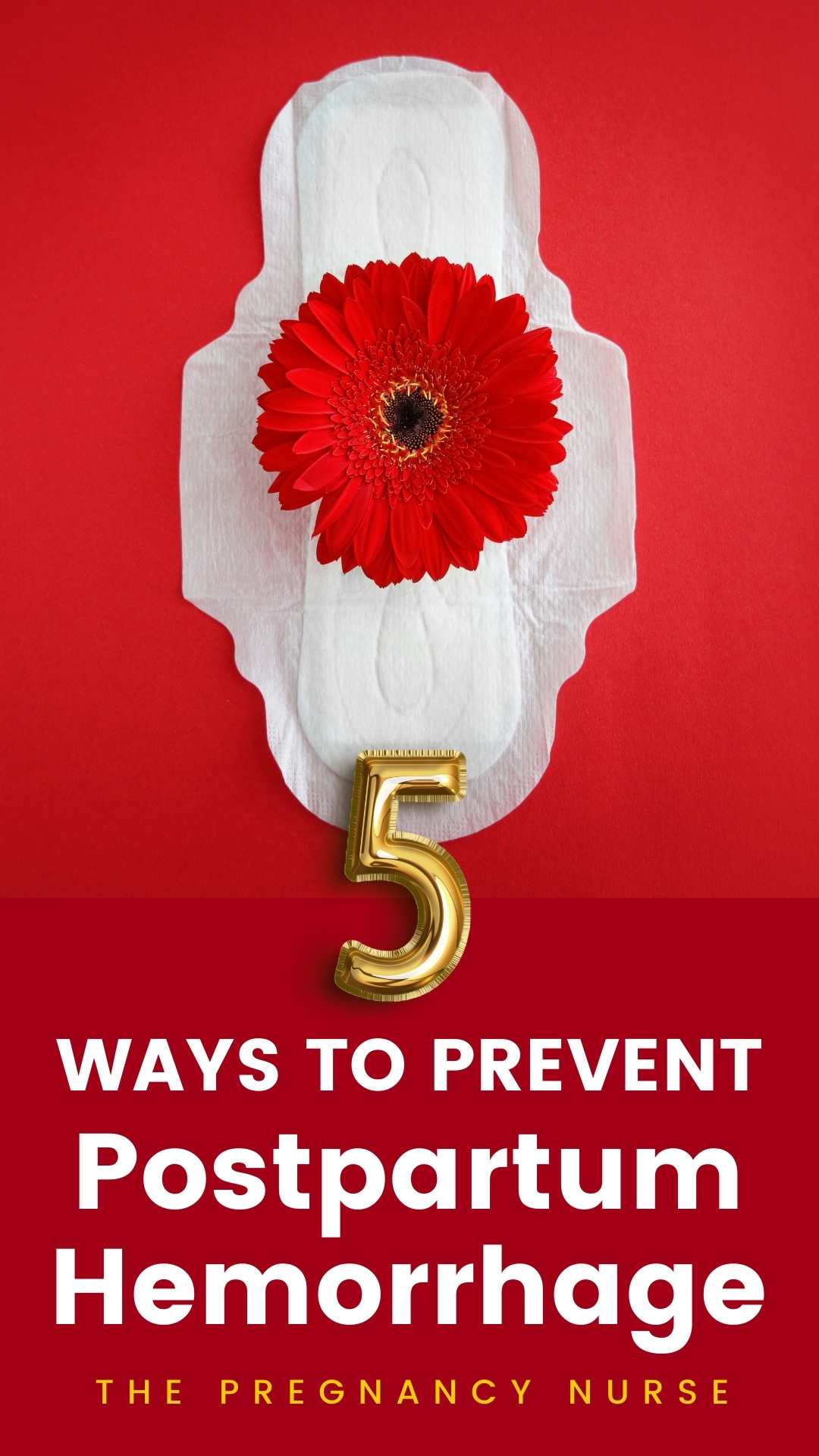You might have heard that bleeding out is one of the most likely ways someone could die after having a baby. Today we’re going to talk about 5 ways to prevent postpartum hemorrhage.
But first, how do I know all of this? Hi — I’m Hilary — The Pregnancy Nurse 👩⚕️. I have been a nurse since 1997 and I have 20 years of OB nursing experience, I am also the curly head behind Pulling Curls and The Online Prenatal Class for Couples. 🩺 I have seen patients pick lots of choices during their pregnancy, and what kind of consequences there are — including postpartum hemorrhage.
I even chat about this a bit in my recent videos:
Ways to Prevent Postpartum Hemorrhage
As a note, not all of these are really something you can do about. If your baby needs induction, that is more important than a possible hemorrhage. And, as always be sure to talk to your provider about YOUR issues you might have after baby.
Also, this type of bleeding is VERY different than bleeding you have at 20 weeks.
Don’t Be Induced
Being induced increases your risk for a postpartum hemorrhage. Especially if have a lengthy Pitocin induction. What happens is all your body’s oxytocin (remember Pitocin is just the synthetic form of Oxytocin, so they use the same things in the body) grabbers are filled with Pitocin before baby is born.
Normally, after your placenta is removed, your body releases a ton of Oxytocin. Usually there’s all those grabbers out there waiting to accept it and do their work — but if they’re all already full…. sometimes your body isn’t able to clamp down that uterus like mother nature would want it to.
In reality this goes for people with really extended labors as well, although that is hard to prevent vs not being induced. A short induction is also less likely to have these issues.
Pro Tip: Some studies have shown that once you hit “active labor” with a Pitocin induction your body will keep going on it’s own even if the Pitocin is turned off. You could ask for a Pitocin break once your body hits 6-7 centimeters. That would allow your “Grabbers” to be cleared out and ready to accept the hormone once your placenta is out. Not all providers recommend this, but it could be worth a try.
Love inside information like that last pro tip — don’t miss this class, it’s going to totally help you out!
Get Your Prenatal Labs Taken
I know, I know this won’t exactly PREVENT a hemorrhage, but we will know your starting point. For instance, if you are low on platelets, it gives us time to remedy that (either through nutrition, medication, or if they’re low enough a blood transfusion) BEFORE birth.
Remember the main things we’re looking at that relate to this:
- Hemoglobin & hematocrit — a measurement of your red blood cells
- Platelets — these things help patch up any blood losses (basically what helps in clotting, although it is more complicated in that).
A lot of people think “they’re healthy” and skip that lab work — but don’t do it. They’re simple tests that really can tell us a lot.
Pro Tip: I’m also a HUGE advocate of the diabetes test. Most often there really aren’t any symptoms of gestational diabetes, but it can be a HUGE problem for your growing baby — so taking those prenatal labs is SO important!
Have an IV
Having an IV in allows us to give medications before a hemorrhage happens (or quickly if we see one developing).
If the actual IV makes you feel to “medical” — PLEASE consider a saline lock. I talk all about it in my post on IV fluids in labor. They really are our best way to fight this. The minutes it would take us to insert a line can really mean life or death in some cases.
Medications After Birth
Most often pregnant people who have just delivered their placenta are given extra oxytocin in their IV. Or, if you don’t have an IV it can be given as a shot in your thigh.
We may also consider using other medications if you have had a history of hemorrhage (or someone in your family has, or you have other risk factors like clotting disorders).
Pro Tip: If you have a history of heavy blood loss after a previous pregnancy, don’t hesitate to make that known several times leading up to your delivery, including in the labor room. Most providers will have extra medications in the room if that is the case. If you know why it happened, or if specific things were done like a blood transfusion, things like that are helpful to know as well.
Allow for Uterine Massage
So many people on social media are saying how horrible the uterine massage is after you have a baby. But, this is one of the best ways for us to find out if your uterus is clamping back down or is not, and intervention is necessary.
Why is my uterus “clamping back down”? Do you remember in first aid class, you learned that if you have a wound, you should put pressure on it to stop bleeding? Your uterus does this same thing by applying direct pressure to the sides of the uterus so you don’t bleed out. Think of it as the uterus as a balloon that has the ability to shrink itself back down, and when it does that the walls of the balloon stop the bleeding.
Let me share exactly what happens, so you can prepare for it.
Most places do a “fundal check” every 15 minutes for 2-4 hours after your birth.
- The nurse will lift your gown to check where your belly button is
- She will press down on your abdomen until she feels your uterus
- She will push a bit on your uterus to make sure it is hard
- If the uterus is not hard, she will push more to make it clamp back down.
- She will check your bleeding and any clots that have come out
- She may assess the need for further interventions
You can also check your own uterus (but it is important that the nurse also still feel it since they know exactly what they are looking for).
Come join my class Postpartum Care Made Easy to learn more about what to expect after baby is born:
Ok, so there are five quick things you can do to help prevent postpartum hemorrhage. Of course, there is a lot more to it, but honestly those 5 things prevent a huge percentage of them.
If you’re interested in simple, easy to understand information to help you feel more confident in the labor room, please consider checking out The Online Prenatal Class for Couples. In just a few hours you and your partner can feel more prepared and ready to have this baby.
Looking to get prepare for your birth? I have some easy options for you!
~~~~~~~~
– Worried you’re missing something? Grab my pregnancy planner so you don’t miss a thing!
– Thinking about an induction? Grab Inductions Made Easy to feel prepared in just 20 minutes!
– Wondering how to get that baby OUT? Grab Going Into Labor Made Easy so you know how to (and not to) do it!
– Postpartum got you anxious? Check out Postpartum Care Made Easy so you can stay SAFE even when all your attention is on that little on.
🚨 AND if ALL OF IT has got you on edge The Online Prenatal Class for Couples is perfect for you — You’ll feel so ready before you even know it!
~~~~~~~~
No matter WHERE you are at in your pregnancy journey, we have resources that can help!
Want to do a vibe check before diving into the whole thing with me? — check out my free labor pro tips. It’s your first step toward getting in the driver’s seat of your birth.








 Disneyland Rides for Pregnant People
Disneyland Rides for Pregnant People
